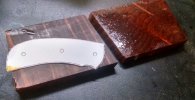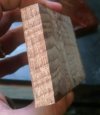- Joined
- May 19, 2018
- Messages
- 203
Hey guys,
So I was getting ready to cut out some scales for a knife I'm working on for my Dad. They're stabilized redwood.
I was sanding off some of the excess resin and dropped one of the pair. It split immediately.
Is this normal for redwood? I have never worked with it before. I have a feeling I bought a dud but I was curious to see what you guys had to say. Pics included
Should probably just buy some from somewhere else?
So I was getting ready to cut out some scales for a knife I'm working on for my Dad. They're stabilized redwood.
I was sanding off some of the excess resin and dropped one of the pair. It split immediately.
Is this normal for redwood? I have never worked with it before. I have a feeling I bought a dud but I was curious to see what you guys had to say. Pics included
Should probably just buy some from somewhere else?


